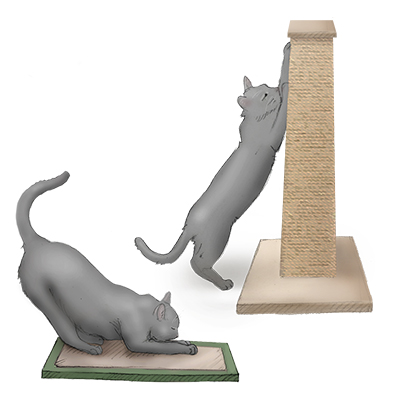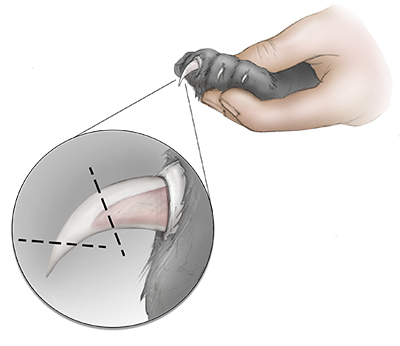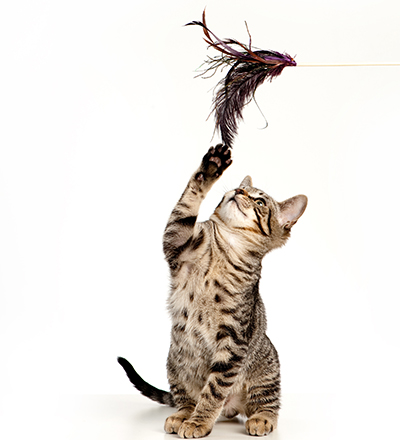Feline Behavior Problems: Destructive Behavior
Many owners complain that their cats scratch furniture and carpets, chew on fabric, or munch on houseplants. These destructive behaviors not only destroy valuable items, but may also harm a cat’s health. One common misconception is that cats are “out for revenge” when they destroy household items, but these behaviors are usually part of normal investigation and play and, fortunately, can most commonly be managed with an appropriate plan and patience.
Scratching
Cats that scratch your favorite sofa or expensive drapes are not on a mission to destroy your home, but rather wish to satisfy certain needs. Scratching is largely a marking behavior that deposits scent from special glands on the cat’s paws into his territory and removes the translucent covering, or sheath, from the claws. The scratch marks and claw sheaths left behind may also be displays of confidence.
Because scratching is an innate behavior like grooming or burying waste, it can be difficult to stop. However, cats can be taught to scratch on more appropriate objects like scratching posts. The following three tactics will help you redirect your cat’s scratching behavior.
Identify scratching preferences
To find out what your cat prefers to scratch on, observe her carefully. Does she prefer carpets, drapes, wood, or some other surface? Does she scratch vertically, with her paws stretched out above her head, or does she prefer horizontal surfaces? Once you have figured out your cat’s preferred target materials and orientation, you can buy a scratching post that suits her needs.
Provide items that match scratching preference
Scratching posts of all shapes, sizes, and textures are available at most pet stores. A carpet-covered post would be a good choice for cats that scratch carpets. If your cat prefers couches and other nubby surfaces, choose a post covered in sisal or some other rope-like material. The scratching post should also match your cat’s preferred scratching orientation. A cat that climbs and scratches on drapes would probably prefer a post tall enough for a long stretch, such as those that mount on a wall or door. However, a cat that likes the horizontal motion of scratching on a carpet might be more likely to use a flattened cardboard box, or a log placed on its side (Figure 1).
Some owners get creative and build their own scratching posts and kitty activity centers. You can cover pieces of wood with carpet, fabric, sisal, or other materials, then nail them together to create a “cat tree” with climbing perches. This will help keep your cat entertained and satisfy her need to scratch. Any scratching post you buy or build should be sturdy enough that it does not topple over during use, and should be at least as tall as your cat standing on her hind legs with front legs outstretched.
Redirect your cat’s scratching behavior by placing the post next to an area your cat likes to scratch. It can then be gradually moved to a location of your choice. If your cat scratches in several locations, provide a post near each one. Take your cat to the new scratching post and reward her with treats, strokes, and praise for using it. You can also entice your cat with treats or catnip placed on or around the post. Do not discard the used scratching post when it looks ragged and worn—that means the post is well used and is serving its intended purpose!
Make unacceptable targets unavailable or less attractive
The only guaranteed way to stop your cat from scratching a given area or object is to restrict access. However, if this is not practical, there are booby traps you can set up to discourage scratching. Build a tower of plastic cups that topples over when bumped to startle your cat when she begins to scratch. Covering items with blankets, sheets of plastic, or double-sided tape may also deter scratching. A more expensive tactic is an indoor fence that delivers a mild, harmless shock when your cat crosses a boundary.
Because scratching has a scent-marking component, cats are more likely to re-scratch areas that already have their scent. To help break this cycle, try using an odor neutralizer to deodorize these areas.
You can further minimize scratching damage by regularly trimming your cat’s nails (see illustration in Figure 2 and https://goo.gl/AqTvkH for a series of demonstration videos) and/or by applying plastic nail caps that can be glued over your cat’s claws. These should only be applied to cats that allow you to handle and manipulate their paws. While wearing these caps, your cat can go through the motions of scratching, but will cause no damage. Replace the caps every six to 12 weeks.
In general, cats do not respond well to punishment because they see no link between the punishment and the “crime.” Punishment only teaches your cat to fear you. Worse, it may lead to aggression. Yelling, squirting a water gun, or startling your cat with a loud noise when he scratches teaches him that your presence, rather than the act of scratching, brings punishment. If your cat is punished for scratching only when you are present, he will simply learn to scratch when you are not there. Effective deterrents to scratching, such as the “tower of cups” booby trap mentioned earlier, are consistent, immediate, and are less likely to result in a cat associating a negative stimulus with its owner.
Declawing is an elective and highly controversial surgical procedure that is the topic of considerable debate among cat owners and veterinary professionals. Despite its name, declawing is actually an amputation of the bones at the tips of the paws, not a simple removal of the nails. Like any other surgical procedure, declawing carries the risk of anesthetic complications, infection, bleeding, and, in rare cases, more long-term problems. Declawing will not curb your cat’s desire to scratch, but will prevent the damage resulting from the behavior. Declawed cats should never be allowed outside, as they are less able to climb trees or to defend themselves. Thoughtful consultation with your veterinarian is recommended if you are considering this procedure for your cat. Declawing should be considered only as an absolute last resort when all other strategies are unsuccessful, and only in cases in which a cat’s scratching would necessitate removal from the home.
Fabric Chewing and Sucking
Fabric chewing and sucking is relatively rare in cats. It may be a comfort-seeking behavior, or it may fulfill a desire to play and investigate. Kittens commonly chew as they explore, and although most outgrow this behavior, some do it for life. It is most commonly seen in Burmese and Siamese cats, which suggests a genetic predisposition comparable to obsessive-compulsive disorders in humans.
Wool is often the fabric of choice, and a cat with a serious chewing habit can destroy sweaters, socks, blankets, pillows, and other valuable items. More importantly, this behavior can be harmful to your cat’s health. Bits of swallowed fabric can cause life-threatening gastrointestinal obstructions. In addition, cats that chew fabric may also chew on dangerous items like electrical cords, twist ties, or even pins and needles.
Prevent access to unacceptable targets/offer alternatives
If necessary, hide all valuable and dangerous chewable objects, leaving out a few non-valuable fabrics for your cat to chew on—so long as he does not swallow too much. Also, try offering your cat alternatives such as cat-safe rubber toys scented with fish oil or even dry cat food. If you choose the latter, make sure that the dry food used is part of your cat’s calculated daily caloric intake (i.e. that this does not result in overfeeding).
Prevent boredom
A cat that habitually chews on inappropriate objects may need other diversions. A home-built or purchased “kitty condo” with crawl spaces, perches, or hanging catnip toys will help occupy your cat’s time. Additionally, try to increase the amount of time you spend playing with him by dangling ribbons or tossing walnuts or ping-pong balls. You can help meet your cat’s need to forage by putting a large ball in the food bowl, or by providing toys that deliver treats when moved or scratched.
Make unacceptable targets less attractive
Spray bad-tasting commercial pet repellents on fabrics to deter chewing. It is best to rotate the positions and types of items sprayed so your cat learns that all fabric tastes bad. Your cat should not be able to predict by smelling which items are sprayed, so choose a repellent without a foul odor. Finally, in severe cases, your veterinarian may prescribe medications that decrease your cat’s desire to chew or suck on inappropriate targets.
Houseplant Chewing
Cats that chew on houseplants are usually indoor cats with little access to grass or other greens. Cats may chew on plants as part of their normal investigation and play, or they may simply be craving vegetable matter in their diets. While most plants are harmless, several can be deadly.
These include:
Caladium (Caladium spp.)
Dumb cane (Dieffenbachia spp.)
English ivy (Hedera helix)
Lilies (Lilium spp.)
Mistletoe (Phoradendron spp.)
Oleander (Nerium oleander)
Philodendron (Philodendron spp.)
Poinsettia (Euphorbia spp.)
Please be aware that this is neither a complete list nor a list of the most common poisonous plants. Consult your veterinarian or local poison control center for more information.
Prevent access/provide alternatives
The only way to guarantee protection for both your houseplants and your cat is to block access to the plants. If your cat craves vegetable matter in her diet, you can provide alternatives, such as oat grass, catnip, and catmint, although she may still continue to snack on houseplants. You can also try adding lettuce or parsley to her food bowl, or switching to a cat food with a higher fiber content.
Make unacceptable targets less attractive
Houseplants can be made less attractive by spraying the leaves with a commercial pet repellent, or spraying water, then sprinkling them with cayenne pepper. The odor of mothballs in the soil may also keep your cat away. Alternatively, the “tower of cups” booby trap placed around the pot can startle your cat when she begins to chew.
Conclusion
Unfortunately, some innate, normal cat behaviors become destructive within the confines of a house. As cat owners, we need to find a balance between protecting our valuables and our cats’ health, while still satisfying our cats’ needs. In some cases, consultation with a veterinarian or veterinary behaviorist may be helpful to address destructive behavior and to devise management strategies that will enable you and your cat to live in peace and good health.
Updated March 2018






